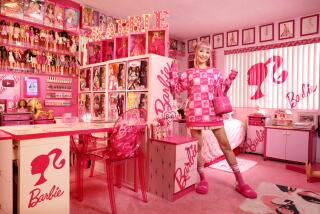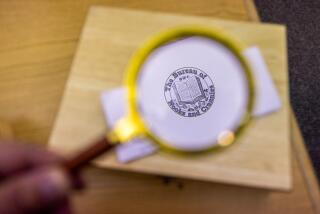Collecting Their Thoughts
- Share via
David Costar is master of a rubbery kingdom. It is a well-organized world populated by bugs, spiders, monsters and superheroes all diligently sorted and categorized in an array of boxes and bags.
“It’s like gold to me,” says David, 9, of Mission Viejo, as he pokes and wriggles his fingers through the Creepy Crawler collection he began on his fifth birthday.
On that day, David unwrapped a little orange and green oven and went into production creating quarter-sized critters from colored goo and metal molds.
From his industry, a collection was born.
It is, as all good collections should be, uniquely his. It is also small, has endless possibilities and doesn’t cost much.
Rocks, sea shells, stickers, book marks, bottle caps, baseball cards, marbles, aluminum pull tabs, slightly sticky candy containers, key chains, magnets, toy cars, pencils and even plain old sticks are all popular with young collectors.
If it can be picked up, piled up or rounded up, kids will collect it. The cheaper, the better.
Why do they do it? Because it’s fun, because it’s their property, thank you very much, and because it’s a normal and almost instinctive way to play with mathematical concepts and organizational schemes, according to experts on childhood.
The childhood passion for collecting is different from the adult version, which can get obsessive and downright weird.
For kids, collecting feels new and exciting, says Sylvia Alva, an associate professor of child and adolescent development at Cal State Fullerton.
At about age 7, children move from that magical realm of childhood where they believe their toys are alive and their stuffed bears can talk into a more logical phase. They notice and remember details about the world around them. It’s when collecting begins with zeal, Alva says.
“This is the stage when children are fairly adept at classifying objects, people, all sorts of things. They have an emerging ability to find patterns. They classify things on several dimensions--the color, the size, the type of object. They have a better understanding of mathematical concepts like addition and subtraction,” Alva says.
A maturing attention span helps them organize all this stuff too.
“When they’re very young, their life is much more sporadic,” Alva says. “They’ll collect something like two or three great rocks, but then they’ll forget where they left them and their life moves on.”
When you have enough rocks to fill a crate used for shipping melons, you don’t move anywhere very quickly, though.
“My mom says she hopes my room doesn’t fall straight into the garage,” says Laura Seelig, 14, as she arranges and rearranges a weighty assemblage of rocks she has been collecting for as long as she can remember. Little rock people decorate her dresser too. And she keeps a few pieces of rock jewelry in her jewelry box.
But the mother lode of her collection is neatly sorted and stored in the hefty melon box. Boxes and bags within the big box keep everything in its place. Like a magician with an endless train of scarves, Laura keeps pulling out her treasures. The opaque rocks. The taffy-colored rocks picked up at school. Bits of obsidian found on vacation. The ones that sparkle. The pumice. The beach rocks. The pencil with tiny pebbles stored at its end. The rock barrette.
As Laura has grown, so too has her rock passion. Nowadays she points out which are sedimentary, knows the rules against taking rocks out of national parks, has a reference book and knows what puts the sparkle in fool’s gold. But she remembers younger days when she spent hours sorting, arranging and playing with them. And, she adds with a smile, bathing them.
“I used to wash them and put powder and lotion and perfume on them,” she says with a soft laugh.
*
Don’t go talking to Jackie Enabnit about the skills she’s developed organizing her animal poster collection. Jackie, 9, of Anaheim, just knows that her bedroom walls look really cool smothered with kittens, puppies and horses. Only a 9-year-old can truly appreciate a picture of a horse with a tousled mane and the caption “Another bad hair day.”
“Mostly they’re just real cute, and I really love animals,” Jackie says.
Ask Bonnie Robison, 7, of Irvine what she likes about her 100-plus bookmarks and she tilts her head thoughtfully. Then she explains that she likes the look of them laid end to end. And they made a great exhibit at the Orange County Fair this summer too.
“Of, course, sometimes I put them in books,” she adds.
All this stuff does make whimsical and wonderful displays, as Kathy Henderson knows well. Henderson oversees the display case that showcases children’s collections in the children’s room at the University Park branch of the Orange County Public Library. At times, the waiting list to get a collection displayed has been two years’ long. But don’t expect the Smithsonian to make a bid. On a recent visit, the case was full of little green Army men and an assortment of handmade ships. There have been Barbies, whales, horses and comics.
“And you wouldn’t believe how many forms and sizes erasers take,” Henderson says.
When children have fun playing with their collections, there’s also something else going on. That’s math, says Alan Hoffer, a professor of education and math researcher at UC Irvine. When children start arranging and sorting their collections with a certain scheme in mind, he says, they are intuitively experimenting with and mastering basic math and thinking skills.
“Classifying is a foundational thinking skill,” Hoffer says.
David Costar and his Creepy Crawlers, which he displayed at the Orange County Fair this summer, are a great example. He sorts them by color, bug type and size. Then there’s his car collection. He doesn’t sort Matchbox from Hot Wheels. Rather, he arranges all emergency vehicles together. Cars sporting snazzy animal names, like the Panther and the Shark line one shelf. School buses sit together on the back of a display shelf in his bedroom.
It’s the wise primary-grade teacher who uses that natural instinct to instill a deeper understanding of basic math concepts, Hoffer says. Young children who understand the concept of “fiveness” as opposed to those who focus on the written symbol and memorized equations are actually on their way to being better mathematicians, Hoffer says.
*
Parents can gently nurture this process at home, Hoffer says. When you see the beginning of a collection, show a little interest. Ask a few questions, comment on some of the differences between the items and maybe suggest separating “the little ones” and “the big ones.”
“The thing is to just listen,” Hoffer says. “Raise questions, like ‘That’s a good way of grouping them together. Why did you do that?’ or ‘Why doesn’t this belong over there in that group?’ But don’t expect them to verbalize something they’re not ready to verbalize.”
And resist the temptation to impose your grown-up view of how they should be organized. Offer up shoe boxes, margarine tubs or an old toolbox, stand back and enjoy.
And if you have a kid like David, consider extra shelving.






